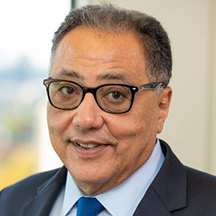In a nutshell
A MENA ‘moonshot’ – an economic approach that embraces innovation and encourages risk-taking and creativity – would involve a collective commitment to achieve parity with advanced economies in information and communications technology by 2022.
The MENA region needs to create a modern broadband internet that covers all countries, including those that are lagging economically.
MENA countries must develop an infrastructure that supports digital money transfer through mobile devices and the internet.
In recent decades, young people in countries in the Middle East and North Africa (MENA) have flocked to universities, but there has not been a commensurate increase in demand for their skills. The perverse result has been that university graduates are more likely to be unemployed than those with less education (see Figure 1). This adds to social unease and retards economies by failing to employ their most educated and potentially highly productive workers.
To change that calculus, MENA must rapidly create a new economic reality that can deliver opportunities for all its young people. The old state-led economic model, which is still entrenched in many MENA countries, has reached its limit and can no longer provide the necessary jobs, let alone high-quality ones.
A growth model based on labour-intensive light manufacturing, such as the one followed by East Asian countries, cannot resolve the problem of unemployed university graduates. Moreover, this growth path may no longer work because new technologies are rapidly changing the nature of manufacturing.
The most promising approach for MENA countries is to adopt a technology-based economic model that embraces innovation and encourages risk-taking and creativity. Such a model can provide opportunities for well-educated workers.
Moreover, high-tech applications, such as job-matching platforms, can help less educated workers to find jobs. This will require the creation of a modern telecommunications system that enables an inclusive digital economy and the financial infrastructure to underpin that economy.
To achieve such an ambitious agenda, countries must mobilise political support and stir the public imagination. They cannot do that if they continue the traditional incremental approach to change. Without a full-blown effort, a generation of MENA youth will be condemned to unemployment or low-productivity, low-wage employment. And the technological gap between the MENA region and the rest of the world will continue to widen.
MENA countries must undertake what might be called a ‘moonshot’ – an all-out effort to achieve a goal named after the massive US effort in the 1960s to land a man on the moon. President John F. Kennedy’s 1961 decision to pursue this objective unleashed an extraordinary collective national effort that achieved its seemingly impossible goal in mid-1969.
A MENA moonshot would involve a collective commitment to achieve parity with advanced economies in information and communications technology by 2022. MENA countries would seek to equal or better OECD countries in terms of their level of access to the internet, capacity to transmit data (bandwidth) and the number of financial transactions carried out electronically.
The effort to create modern telecommunications and payments systems will require specific and bold goals, firm deadlines and cooperation among all elements of society, including the private sector.
Some of the needed elements are in place already. Young people in MENA are digitally savvy in many ways. They are active on social media and they are heavy users of mobile phones. Mobile phone penetration in the region is among the highest in the world (see Figure 2).
But that is about as far as it goes. The quality of internet service in most MENA countries is poor and few people have access to it. Only in sub-Saharan Africa and South Asia is there a lower per capita level of broadband subscriptions and MENA users have a limited amount of bandwidth per subscriber (see Figure 2).
Digital finance is almost non-existent. The poor quality of internet and payments systems hinder the development of a modern economy that creates quality jobs for its citizens (see Figure 3).
But digital infrastructure cannot be brought up to speed without overhauling the region’s regulatory apparatus. Regulators too often see the world through a prudential lens – pre-disposed to limit risks, but blind to catalysing innovation or encouraging competition. Allowing new firms to enter either the telecommunications or financial industries would lower prices and increase quality. But in both sectors, incumbents and regulators make entry difficult and retard innovation (see Figure 4).
Unlike countries in Latin America or Central and East Asia, which have aggressively pushed competition and liberalisation in the telecommunications sector, MENA countries have pursued a very gradual approach to change. As a result, Latin American and Asian countries, which a decade ago had internet speeds and usage comparable to MENA, have not only far surpassed the Arab world, they rival advanced economies.
Regulation has so retarded the growth of digital payments in the region, especially in North Africa, that much poorer countries in East Africa outperform MENA in terms of the diffusion of mobile money. Policy-makers should study Kenya’s model of light but effective regulation, which has fostered the rapid growth of the peer-to-peer payment system, M-Pesa.
In preparing for the moonshot, authorities in MENA should set two bold goals and plan to accomplish them swiftly, say within four years:
- First, they need to create a modern broadband internet that covers all countries, including those that are lagging economically.
- Second, countries must develop an infrastructure that supports digital money transfer through mobile devices and the internet.
To facilitate modern broadband internet and payments systems, regulators face twin challenges:
- They must encourage new entrants and enhanced competition.
- In a region that has been dominated by public banks, they must build trust in the integrity and security of digital finance in a private market.
As President Kennedy’s 1961 decision galvanised the United States, a 2018 MENA moonshot could unite authorities and young people behind a common goal – and transform the ways in which governments, companies, international financial institutions, foundations, civil societies and even foreign governments conduct business and collaborate. It would transform MENA economies and help to ensure that millions of the region’s young people can find the good jobs they deserve.
Figure 1:
Educated but unemployed
Figure 2:
High mobile penetration but low internet penetration
Figure 3:
Poor quality internet and nearly no cashless payment
Figure 4:
High concentration in the telecommunications sector







